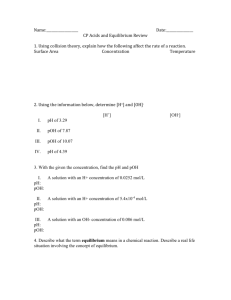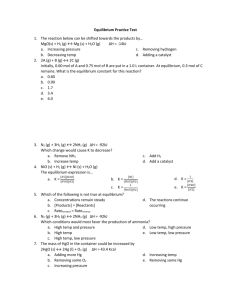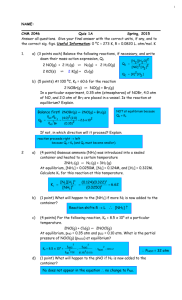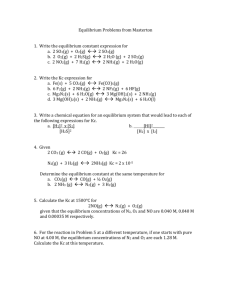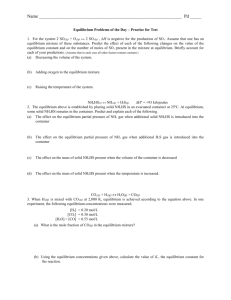AP Equilibrium Review Free Response 2003B #1 After a 1.0 mole
advertisement
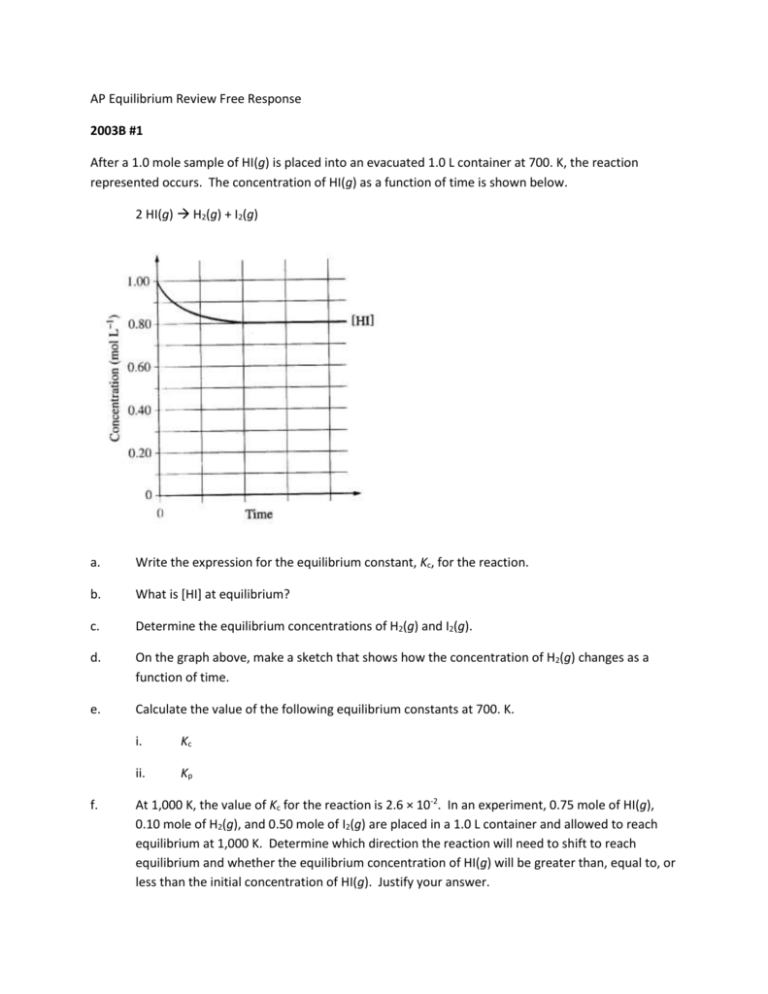
AP Equilibrium Review Free Response 2003B #1 After a 1.0 mole sample of HI(g) is placed into an evacuated 1.0 L container at 700. K, the reaction represented occurs. The concentration of HI(g) as a function of time is shown below. 2 HI(g) H2(g) + I2(g) a. Write the expression for the equilibrium constant, Kc, for the reaction. b. What is [HI] at equilibrium? c. Determine the equilibrium concentrations of H2(g) and I2(g). d. On the graph above, make a sketch that shows how the concentration of H2(g) changes as a function of time. e. Calculate the value of the following equilibrium constants at 700. K. f. i. Kc ii. Kp At 1,000 K, the value of Kc for the reaction is 2.6 × 10-2. In an experiment, 0.75 mole of HI(g), 0.10 mole of H2(g), and 0.50 mole of I2(g) are placed in a 1.0 L container and allowed to reach equilibrium at 1,000 K. Determine which direction the reaction will need to shift to reach equilibrium and whether the equilibrium concentration of HI(g) will be greater than, equal to, or less than the initial concentration of HI(g). Justify your answer. 2000 1. 2 H2S(g) 2 H2(g) + S2(g) When heated, hydrogen sulfide gas decomposes according to the equation above. A 3.40 g sample of H2S(g) is introduced into an evacuated rigid 1.25 L container. The sealed container is heated to 483 K, and 3.7210–2 mol of S2(g) is present at equilibrium. (a) Write the expression for the equilibrium constant, Kc, for the decomposition reaction represented above. (b) Calculate the equilibrium concentration, in molL-1, of the following gases in the container at 483 K. (i) H2(g) (ii) H2S(g) (c) Calculate the value of the equilibrium constant, Kc, for the decomposition reaction at 483 K. (d) Calculate the partial pressure of S2(g) in the container at equilibrium at 483 K. (e) For the reaction H2(g) + constant, Kc. 1 2 S2(g) H2S(g) at 483 K, calculate the value of the equilibrium 1992 A 2 NaHCO3(s) Na2CO3(s) + H2O(g) + CO2(g) Solid sodium hydrogen carbonate, NaHCO3, decomposes on heating according to the equation above. (a) A sample of 100. grams of solid NaHCO3 was placed in a previously evacuated rigid 5.00liter container and heated to 160ºC. Some of the original solid remained and the total pressure in the container was 7.76 atmospheres when equilibrium was reached. Calculate the number of moles of H2O(g) present at equilibrium. (b) How many grams of the original solid remain in the container under the conditions described in (a)? (c) Write the equilibrium expression for the equilibrium constant, KP, and calculate its value for the reaction under the conditions in (a). (d) If 110. grams of solid NaHCO3 had been placed in the 5.00-liter container and heated to 160ºC, what would the total pressure have been at equilibrium? Explain. 1980 A Methylamine CH3NH2, is a weak base that ionizes in solution as shown by the following equation. CH3NH2 + H2O CH3NH3+ + OH– (a) At 25ºC the percentage ionization in a 0.160 molar solution of CH3NH2 is 4.7%. Calculate [OH–], [CH3NH3+], [CH3NH2], [H3O+], and the pH of a 0.160 molar solution of CH3NH2 at 25ºC (b) Calculate the value for Kb, the ionization constant for CH3NH2, at 25ºC. 1998 D C(s) + H2O(g) CO(g) + H2(g) Hº = +131kJ A rigid container holds a mixture of graphite pellets (C(s)), H2O(g), CO(g), and H2(g) at equilibrium. State whether the number of moles of CO(g) in the container will increase, decrease, or remain the same after each of the following disturbances is applied to the original mixture. For each case, assume that all other variables remain constant except for the given disturbance. Explain each answer with a short statement. (a) Additional H2(g) is added to the equilibrium mixture at constant volume. (b) The temperature of the equilibrium mixture is increased at constant volume. (c) The volume of the container is decreased at constant temperature. (d) The graphite pellets are pulverized. 1984 A Sodium benzoate, C6H5COONa, is the salt of a the weak acid, benzoic acid, C6H5COOH. A 0.10 molar solution of sodium benzoate has a pH of 8.60 at room temperature. (a) Calculate the [OH–] in the sodium benzoate solution described above. (b) Calculate the value for the equilibrium constant for the reaction: C6H5COO– + H2O ↔ C6H5COOH + OH– (c) Calculate the value of Ka, the acid dissociation constant for benzoic acid. 1995 A CO2(g) + H2(g) H2O(g) + CO(g) When H2(g) is mixed with CO2(g) at 2,000 K, equilibrium is achieved according to the equation above. In one experiment, the following equilibrium concentrations were measured. [H2] = 0.20 mol/L [CO2] = 0.30 mol/L [H2O] = [CO] = 0.55 mol/L (a) What is the mole fraction of CO(g) in the equilibrium mixture? (b) Using the equilibrium concentrations given above, calculate the value of Kc, the equilibrium constant for the reaction. (c) Determine Kp in terms of Kc for this system. (d) When the system is cooled from 2,000 K to a lower temperature, 30.0 percent of the CO(g) is converted back to CO2(g). Calculate the value of Kc at this lower temperature. (e) In a different experiment, 0.50 mole of H2(g) is mixed with 0.50 mole of CO2(g) in a 3.0-liter reaction vessel at 2,000 K. Calculate the equilibrium concentration, in moles per liter, of CO(g) at this temperature. ANSWERS 2003B#1 10 points total a. b. Kc [H 2 ][I 2 ] 2 1 point [HI] From the graph, [HI]eq is 0.80 M c. 1 point 2HI(g) --> H2(g) + I2(g) 1.0 M 0M 0M chang -0.20 M +0.10 M +0.10 M eq 0.10 M 0.10 M init 0.80 M [H2] = [I2] = 0.10 M 1 point for stoichiometric relationship between HI and H2 and I2 1 point for equilibrium concentrations of H2 and I2 d. From the graph, [H2]eq is 0.10 M. The curve should have the following characteristics: start at 0 M, increase to 0.10 M, reach equilibrium at the same time [HI] reaches equilibrium 1 point for any two characteristics, 2 points for all three characteristics e. i) K c [H 2 ][I 2 ] (0.10)(0.10) 0.016 [HI] 2 (0.80) 2 1 point for correct substitution which must agree with parts b and c ii) KP = Kc = 0.016 because the number of moles of gaseous products is equal to the number of moles of gaseous reactants 1 point Q f. [H 2 ][I 2 ] (0.10)(0.50) 0.089 [HI] 2 (0.75)2 Kc = 0.026, Q > Kc, therefore to establish equilibrium, the numerator must decrease and the denominator must increase. Therefore, [HI] will increase. 1 point for calculating Q and comparing to Kc 1 point for predicting correct change in [HI] 2000A Answer: [H2]2[S2] (a) Kc = [H2S]2 (b) (i) 3.7210–2 mol S2 2 mol H2 –2 1.25 L 1 mol S2 = 5.9510 M H2 (ii) 2 mol H 2S 1 mol -2 3.40 g H 2S 34.0 g - 3.72 10 mol S2 1 mol S 2 1.25 L = 2.0510–2 M H2S 2 2 3.72 10 5.952 102 1.25 (c) Kc = = 0.251 2 0.02048 (d) PV=nRT = 1.18 (e) K’c = 1 Kc = 2.00 1992 A Answer: (a) ngas PV (7.76 atm)(5.00 L) 1.09 mol Lgatm RT 0.0821 molgK 433 K mol H2O = (1/2)(1.09 mol) = 0.545 mol H2O(g) 2 mol NaHCO 3 84.0 g NaHCO 3 (b) 0.545 mol H 2O = 91.9 g NaHCO3 decomposed 1 mol H 2O 1 mol remaining = 100.g - 91.6g = 8.4g OR 18.0 g 44.0 g 100 - 0.545 mol H 2 O 0.545 mol CO 2 1 mol 1 mol = 100g - 33.8g = 66g (or 66.2g) [includes Na2CO3 solid in this mass] (c) Kp = (PH2O)(PCO2) =(3.88)(3.88)atm2 = 15.1 atm2 (d) Pressure would remain at 7.76 atm. Since some solid remained when 100.g was used (and there has been no temperature change), then using 110g will not affect the equilibrium. 1980 A Answer: (a) CH3NH2; 0.160M x 4.7% = 7.5×10–3 M ionizing (0.160M – 0.0075M) = 0.0152M @ equilibrium [CH3NH3+] = [OH–] = 7.5×10–3 M Kw [H3O+] = = 1.310-12 M 7.5 10 3 pH = –log [H3O+] = 11.89 [CH 3NH 3+ ][OH- ] (7.5 10 3 )2 (b) Kb = =3.710–4 [CH 3NH 2 ] 0.152 1998D Answer (a) CO will decrease. An increase of hydrogen gas molecule will increase the rate of the reverse reaction which consumes CO. A LeChatelier Principle shift to the left. (b) CO will increase. Since the forward reaction is endothermic (a H > 0) an increase in temperature will cause the forward reaction to increase its rate and produce more CO. A LeChatelier Principle shift to the right. (c) CO will decrease. A decrease in volume will result in an increase in pressure, the equilibrium will shift to the side with fewer gas molecules to decrease the pressure, , a shift to the left. (d) CO will remain the same. Once at equilibrium, the size of the solid will affect neither the reaction rates nor the equilibrium nor the concentrations of reactants or products. 1984 A Sodium benzoate, C6H5COONa, is the salt of a the weak acid, benzoic acid, C6H5COOH. A 0.10 molar solution of sodium benzoate has a pH of 8.60 at room temperature. (a) Calculate the [OH–] in the sodium benzoate solution described above. (b) Calculate the value for the equilibrium constant for the reaction: C6H5COO– + H2O ↔ C6H5COOH + OH– (c) Calculate the value of Ka, the acid dissociation constant for benzoic acid. (d) A saturated solution of benzoic acid is prepared by adding excess solid benzoic acid to pure water at room temperature. Since this saturated solution has a pH of 2.88, calculate the molar solubility of benzoic acid at room temperature. Answer: (a) pH =8.6, pOH =5.4 [OH–] =10–pOH = 3.9810–6M (b) [C6H5COOH] = [OH–] [C6 H 5COOH][OH- ] (3.98 10 6 )2 Kb = = 1.5810–10 [C6 H 5COO- ] (0.10 3.98 10 6 ) (c) Ka = K w 1.0 10 14 = 6.3310-5 10 K a 1.58 10 (d) pH 2.88 = 1.3210–3M [H+] = [C6H5COO–] [H + ][C6 H 5COO- ] (1.32 10 3 )2 [C6H5COOH] = = 2.7510–2M Ka 6.33 10 5 total dissolved = (2.75×10–2M + 1.32×10–3M as ions) = 2.88×10–2M 1995 A CO2(g) + H2(g) H2O(g) + CO(g) When H2(g) is mixed with CO2(g) at 2,000 K, equilibrium is achieved according to the equation above. In one experiment, the following equilibrium concentrations were measured. [H2] = 0.20 mol/L [CO2] = 0.30 mol/L [H2O] = [CO] = 0.55 mol/L (a) What is the mole fraction of CO(g) in the equilibrium mixture? (b) Using the equilibrium concentrations given above, calculate the value of Kc, the equilibrium constant for the reaction. (c) Determine Kp in terms of Kc for this system. (d) When the system is cooled from 2,000 K to a lower temperature, 30.0 percent of the CO(g) is converted back to CO2(g). Calculate the value of Kc at this lower temperature. (e) In a different experiment, 0.50 mole of H2(g) is mixed with 0.50 mole of CO2(g) in a 3.0-liter reaction vessel at 2,000 K. Calculate the equilibrium concentration, in moles per liter, of CO(g) at this temperature. Answer: 0.55 mol (a) CO = = 0.34 1.6 mol [H 2O][CO] (0.55)(0.55) (b) Kc = = 5.04 [H 2 ][CO 2 ] (0.20)(0.30) (c) since n = 0, Kc = Kp (d) [CO] = 0.55 - 30.0% = 0.55 - 0.165 = 0.385 M [H2O] = 0.55 - 0.165 = 0.385 M [H2] = 0.20 + 0.165 = 0.365 M [CO2] = 0.30 + 0.165 = 0.465 M K = (0.385)2/(0.3650.465) = 0.87 (e) let X = [H2] to reach equilibrium [H2] = 0.50 mol/3.0L - X = 0.167 - X [CO2] = 0.50 mol/3.0L - X = 0.167 - X [CO] = +X ; [H2O] = +X K = X2/(0.167 - X)2 = 5.04 ; X = [CO] = 0.12 M


